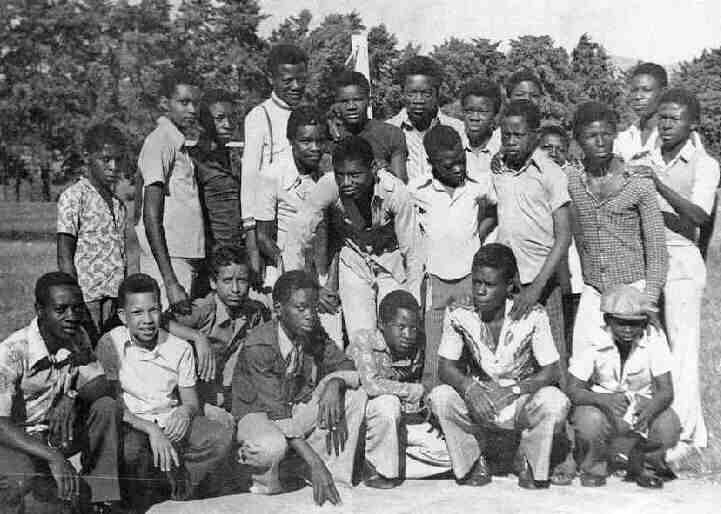
Democratic Republic of the Congo / Zaire: Education

Figure 1.--Here is a group of students at the Collège Alfajiri in Bukavu during 1975. The town was located near Lake Kivu close to the Rwanda border. Unill independence in 1960 this was a school for Belgian children whose families were working in the Congo. Bukavu has been the location of heavy fighting since the Rwanda Genocide (1993). I'm not sure if the school is still functioning.
|
|
The Democratic Republic of Congo was a Belgian colony until 1960. The Belgian Congo covered an emense area of central Africa. King Leopold administered the colony as his own private fiefdom and terrible attrocities were committed by the Belgians during his reign. The Belgian Government took colony took over administration (1908). Very little attention was given to education. Christian missionasries, however, did persue education. The predominantly Catholic missionary effort constructed an impressive school system. By mid-century about 10 percent of Congolese children are attending primary school, compared to just 3 percent in neighbouring French Equatorial Africa. Belgium granted the country independence (1960), but had not prepared it for independence. While mineral rich, the country has drifted back and forth between turbulance, civil war and dictatorial rule. The country changed its name to Zaire (1971-1997). Much of the basic educational system left by the Christian missdionasries has deteriorated.
The Democratic Republic of Congo was a Belgian colony until 1960. The Belgian Congo covered an emense area of central Africa. King Leopold administered the colony as the Congo Free State. It was essentially his own private fiefdom
and terrible attrocities were committed by the Belgians during his reign. As far as I know, no effort was made by the Congo Free State to educate the Congolese. Roman Catholic missionaries presumably opened some primary schools. The Belgian Government took over administration of the colony (1908). A extensive educational sysem was founded, mostly at the primary level. The Catholic Church continued to play a major role in education. By mid-century about 10 percent of Congolese children are attending primary school, compared to just 3 percent in neighbouring French Equatorial Africa. Only a few Congolese advanced to the secondary level. Belgian officials finally opened two universities (mid-1950s). At the time of independece, however, almost know Congolese had university degrees. The colony was almost totally unprepared for indeopendence.
Democratic Republic of the Congo (1960- )
Belgium granted the country independence (1960), but had not prepared it for independence. While mineral rich, the country has drifted back and forth between turbulance, cuvil war and dicttatorial rule. The country changed its name to Zaire (1971-1997). Belgiam left a basic educational system, but much of it appears to have has deteriorated in the chaos since independence.
.
Carefull, clicking on these will exit you from the Boys' Historical Clothing web site, but several are highly recommended
Apertures Press New Zealand book: New book on New Zealand schools available
School Uniform Web Site: Informative review of British school uniforms with some excellent photographs
British Preparatory Schools: A photographic book depicting life at British preparatory schools during the 1980s. Most of the schools are English or Scottish, but schools in Italy, New Zealand, South Africa, and Ulster are also included. The pictures show the uniforms worn at many different schools.
Information: Information about school uniforms in America
HBC

Related Chronolgy Pages in the Boys' Historical Web Site
[The 1880s]
[The 1890s]
[The 1900s]
[The 1910s]
[The 1920s]
[The 1930s]
[The 1940s]
[The 1930s]
[The 1940s]
[The 1950s]
[The 1960s]
[The 1970s]
[The 1980s]
Related Style Pages in the Boys' Historical Web Site
[Long pants suits]
[Knicker suits]
[Short pants suits]
[Socks]
[Eton suits]
[Jacket and trousers]
[Blazer]
[School sandals]
[School smocks]
[Sailor suits]
[Pinafores]
[Long stockings]
Navigate the Boys' Historical Clothing Web Page
[Return to the Main Democratic Republic of the Congo page]
[Return to the Main African school uniform country page]
[Introduction]
[Activities]
[Biographies]
[Chronology]
[Clothing styles]
[Countries]
[Bibliographies]
[Contributions]
[FAQs]
[Glossary]
[Images]
[Links]
[Registration]
[Tools]
[Boys' Clothing Home]
Created: 7:29 PM 5/28/2007
Last updated: 7:29 PM 5/28/2007




